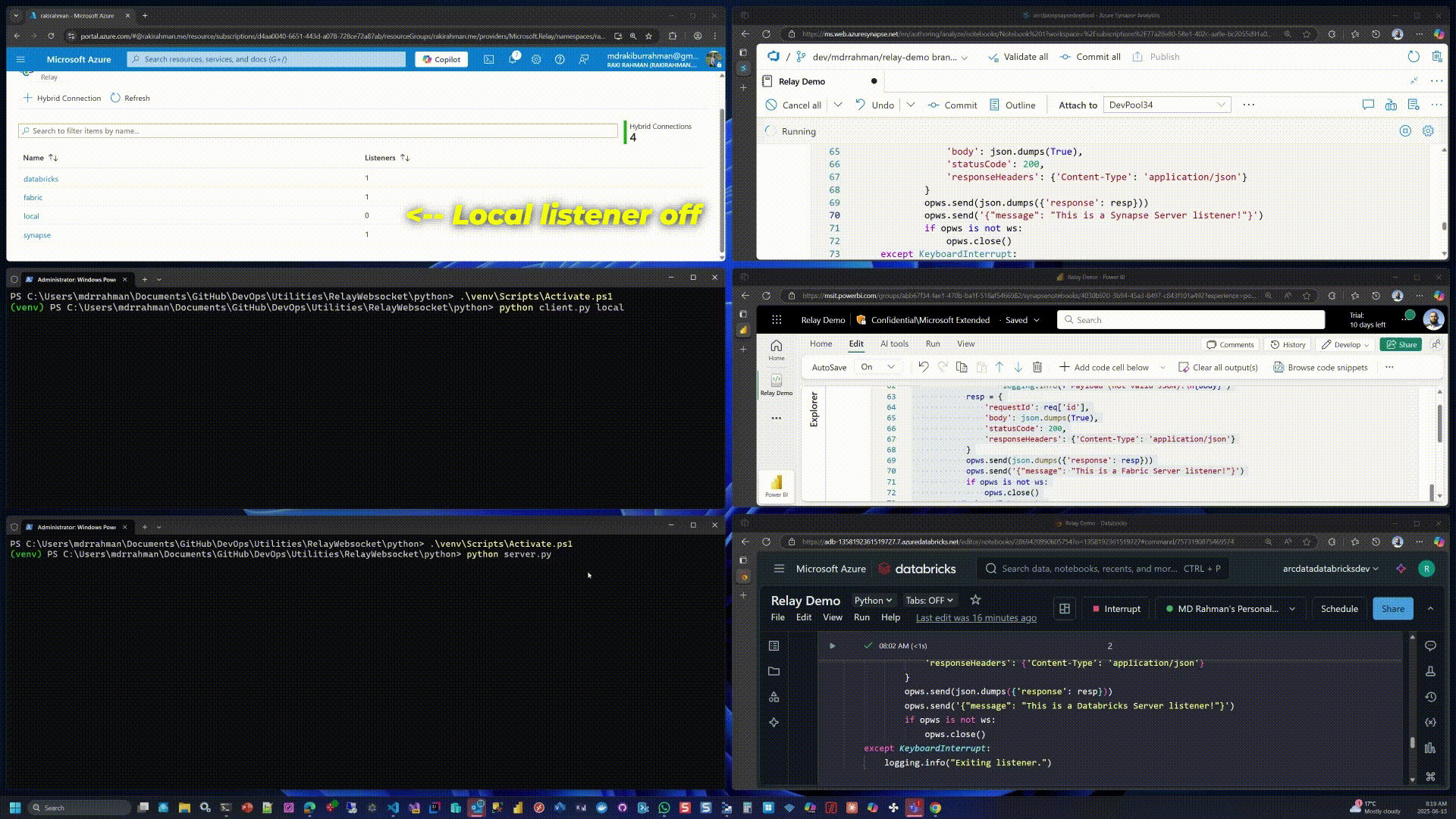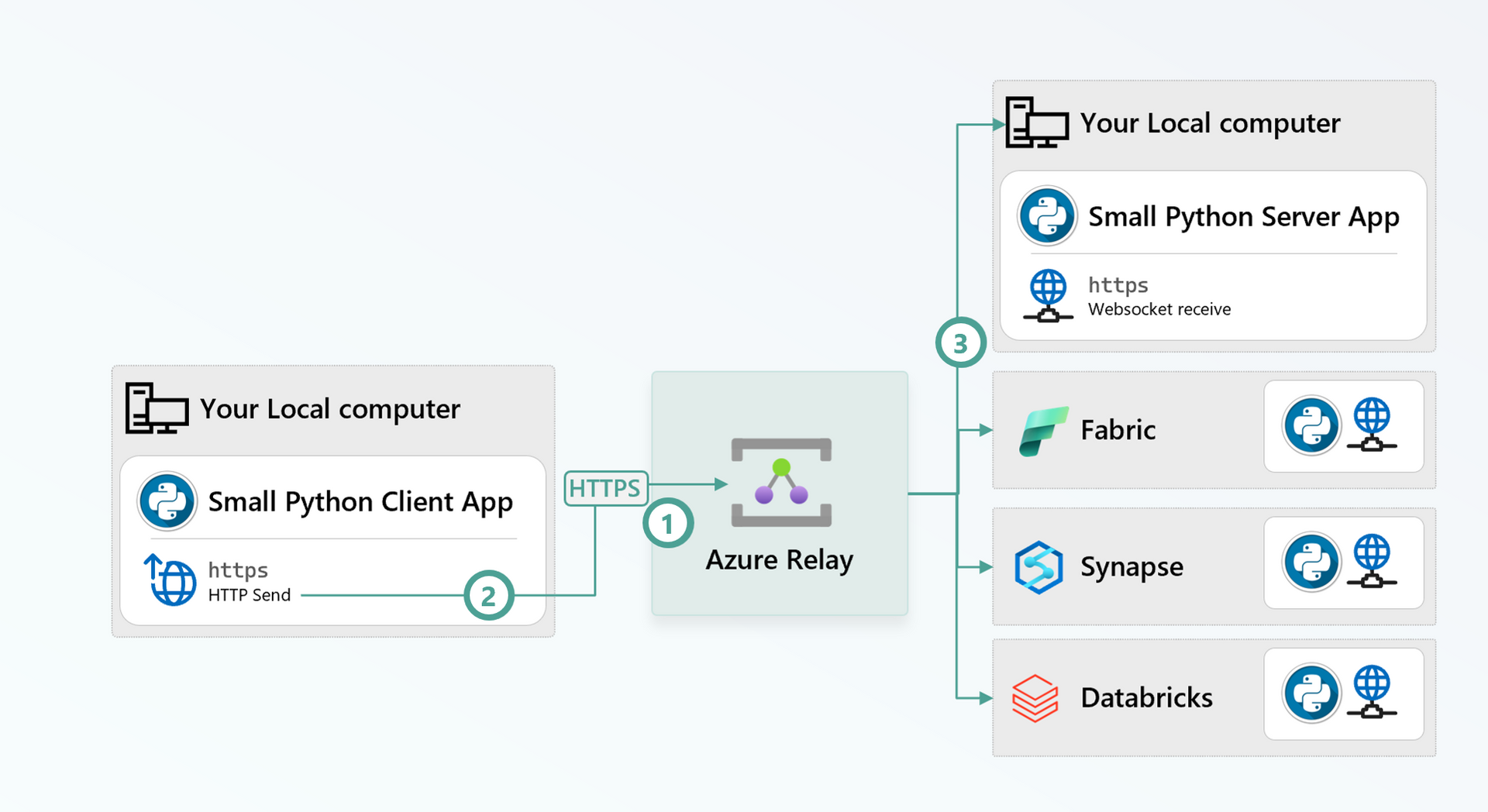How to setup a secured tunnel from your local machine to Fabric, Databricks, Synapse or anywhere else
Azure Relay is a delightful little Azure service that allows 2 globally distributed parties to communicate synchronously - see architecture. Services such as VSCode Remote tunnel use it.
We're going to follow this tutorial to make it work in remote Spark Notebook environments:
- Cloud listeners establish websockets against a particular named Hybrid Connection.
- Local machine client app initiates an HTTPS request to a particular named Hybrid Connection.
- Request and response between the 2 parties are rendezvoused by the Relay.
Here's a demo:

The setup is identical in all the Server environments.
First, follow this doc to create a Relay Namespace and Hybrid Connections per environment (local, fabric, synapse, databricks) - takes 30 seconds.
In the Cloud Notebook server, the only dependency is a websocket package:
# Fabric and Databricks use "!", Synapse uses "%"
!pip install websocket-client==1.8.0Run this in a notebook cell for the server code:
import base64, hashlib, hmac, math, time, urllib, json, logging, websocket
def hmac_sha256(key, msg):
hash_obj = hmac.new(key=key, msg=msg, digestmod=hashlib._hashlib.openssl_sha256)
return hash_obj.digest()
def createListenUrl(serviceNamespace, entityPath, token = None):
url = 'wss://' + serviceNamespace + '/$hc/' + entityPath + '?sb-hc-action=listen&sb-hc-id=123456'
if token is not None:
url = url + '&sb-hc-token=' + urllib.parse.quote(token)
return url
def createSasToken(serviceNamespace, entityPath, sasKeyName, sasKey):
uri = "http://" + serviceNamespace + "/" + entityPath
encodedResourceUri = urllib.parse.quote(uri, safe = '')
# Define the token validity period in seconds (48 hours in this case)
tokenValidTimeInSeconds = 60 * 60 * 48
unixSeconds = math.floor(time.time())
expiryInSeconds = unixSeconds + tokenValidTimeInSeconds
# Create the plain signature string by combining the encoded URI and the expiry time
plainSignature = encodedResourceUri + "\n" + str(expiryInSeconds)
# Encode the SAS key and the plain signature as bytes
sasKeyBytes = sasKey.encode("utf-8")
plainSignatureBytes = plainSignature.encode("utf-8")
hashBytes = hmac_sha256(sasKeyBytes, plainSignatureBytes)
base64HashValue = base64.b64encode(hashBytes)
# Construct the SAS token string
token = "SharedAccessSignature sr=" + encodedResourceUri + "&sig=" + urllib.parse.quote(base64HashValue) + "&se=" + str(expiryInSeconds) + "&skn=" + sasKeyName
return token
def run_application(config):
ns = config["namespace"] + ".servicebus.windows.net"
token = createSasToken(ns, config["path"], config["keyrule"], config["key"])
wssUri = createListenUrl(ns, config["path"], token)
logging.basicConfig(level=logging.INFO, format='%(asctime)s.%(msecs)03d - %(levelname)s - %(message)s', datefmt='%H:%M:%S')
try:
ws = websocket.create_connection(wssUri)
logging.info("Listening for messages on Azure Relay WebSocket...")
while True:
cmd = json.loads(ws.recv())
req = cmd.get('request')
logging.info(f"Received request:\n{json.dumps(req, indent=2)}")
opws = ws
if req and 'method' not in req:
opws = websocket.create_connection(req['address'])
cmd = json.loads(opws.recv())
req = cmd['request']
body = None
if req and req.get('body'):
body = opws.recv()
try:
body = json.loads(body)
logging.info(f"Payload (parsed as JSON):\n{json.dumps(body, indent=2)}")
except json.JSONDecodeError:
logging.info(f"Payload (not valid JSON):\n{body}")
resp = {
'requestId': req['id'],
'body': json.dumps(True),
'statusCode': 200,
'responseHeaders': {'Content-Type': 'application/json'}
}
opws.send(json.dumps({'response': resp}))
opws.send('{"message": "This is a Fabric Server listener!"}')
if opws is not ws:
opws.close()
except KeyboardInterrupt:
logging.info("Exiting listener.")Finally, initiate the server:
config = {
"namespace": "your-relay-namespace",
"path": "fabric",
"keyrule": "RootManageSharedAccessKey",
"key": "..."
}
run_application(config)Then, on the client side, run python client.py fabric:
import json, logging, requests, sys
def createHttpSendUrl(serviceNamespace, entityPath, token=None):
url = 'https://' + serviceNamespace + '/' + entityPath + '?sb-hc-action=connect&sb-hc-id=123456'
if token is not None:
url = url + '&sb-hc-token=' + urllib.parse.quote(token)
return url
def run_application(path, message, config):
ns = config["namespace"] + ".servicebus.windows.net"
url = createHttpSendUrl(ns, path, createSasToken(ns, path, config["keyrule"], config["key"]))
logging.basicConfig(level=logging.INFO, format='%(asctime)s.%(msecs)03d - %(levelname)s - %(message)s', datefmt='%H:%M:%S')
try:
r = requests.post(url, headers={"Content-Type": "application/json"}, data=json.dumps({"message": message}), timeout=5)
logging.info("HTTP status: %s", r.status_code)
logging.info(f"Response (parsed as JSON):\n{json.dumps(json.loads(r.text), indent=2)}")
except Exception as e:
logging.error("An error occurred: %s", e)
if __name__ == "__main__":
if len(sys.argv) != 2:
raise ValueError("Usage: python client.py <message>")
with open("config.json") as f:
run_application(sys.argv[1], "This is a message to Azure Relay Hybrid Connections!", json.load(f))Enjoy the distributed communication!
